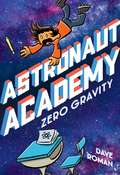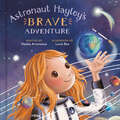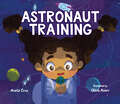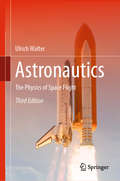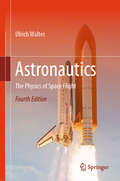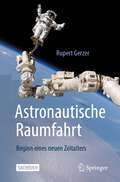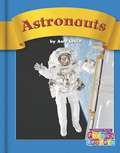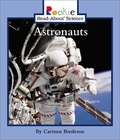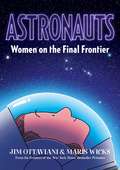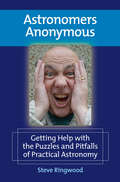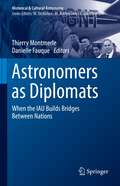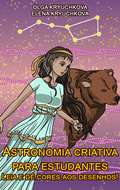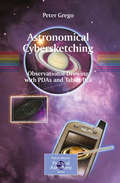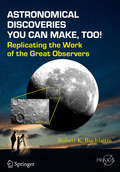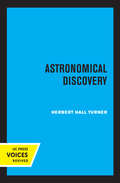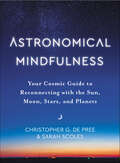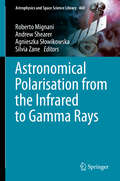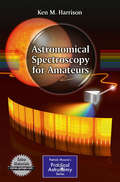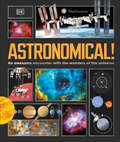- Table View
- List View
Astronaut Academy: Splashdown (Astronaut Academy #3)
by Dave RomanAstronaut Academy: Splashdown is the exciting third installment of the middle grade graphic novel series from author Dave Roman.Heroes like Hakata Soy don’t take vacation!It’s summer vacation for the students of Astronaut Academy, and Maribelle Mellonbelly is throwing the best party ever on Beach Planet? Yes! But tensions heat up fast when Hakata Soy’s arch rival, Rick Raven, arrives. And soon the whole planet is heating up—with a giant volcano threatening to blow its top!Unless they can work together save the planet, the students of Astronaut Academy will betoast. But can they put aside their differences in time to turn the tides?
Astronaut Academy: Zero Gravity (Astronaut Academy #1)
by Dave RomanBeautifully updated with fresh color, this new edition Astronaut Academy: Zero Gravity is the first volume of the middle-grade graphic novel series from Dave Roman.Hakata Soy’s past won’t stay in the past!This former space hero is doing his best to keep his head down at Astronaut Academy. Things aren’t going so great, though. The most popular girl in school has it in for him. His best friend won’t return his calls. And his new roommate is a complete jock who only cares about Fireball.Hakata just wants to make a fresh start. But how will he find time to study Anti-GravityGymnastics and Tactical Randomness when he’s got a robot doppelganger on its way to kill him?
Astronaut Annie
by Suzanne Slade Nicole TadgellBrightly List: Best Children's Books of March 2018 Annie’s joyful exuberance and her family’s whole-hearted support leave no doubt that her dream is within her grasp. This delightful story—with backmatter about women astronauts—encourages young readers to pursue their dreams and reach for the stars. Career Day is approaching, and Annie can’t wait to show her family what she’s planning to be when she grows up. But, she must keep it a secret until Friday! So curious family members each ask Annie for a clue. Convinced that she’ll be a news reporter like he once was, Grandpop gives her his old camera and notebook to use for her presentation. Grandma is sure Annie wants to be a champion baker like her, so she offers a mixing bowl and oven mitts to Annie. Hopeful she'll become the mountain climber he aspired to be, Dad gives Annie an old backpack. Mom presents Annie with a pair of high-top sneakers to pursue Mom's favorite sport in high school -- basketball. Grateful for each gift, Annie cleverly finds a way to use them all to create her Career Day costume. When the big day arrives, Annie finally reveals her out-of-this-world dream to everyone. Fountas & Pinnell Level M Selected for the Red Tricycle Ultimate Summer Reading List! http://redtri.com/summer-reading-list-amazon-kids-edition-tablet/slide/1
Astronaut Hayley's Brave Adventure
by Hayley ArceneauxAn imaginative, inspiring, and beautifully illustrated picture book from the youngest American to ever orbit the earth—cancer survivor Hayley Arceneaux—who learned that if we are willing to be scared and brave at the same time, extraordinary things are possible.A fantastic fictional space story inspired by the author's real-life experiences, Astronaut Hayley&’s Brave Adventure is the perfect book for young readers who have big dreams and even bigger hearts.Like every child, Hayley has to learn to be brave in ordinary ways, like facing the first day of school or trying a new sport. But when Hayley gets sick—really sick—she has to learn to be brave in not-so-ordinary ways. When Hayley is invited to become an astronaut and travel to outer space, she knows she is up for the challenge. But she'll need all her courage to handle what's in store!Astronaut Hayley&’s Brave Adventure will inspire children everywhere to reach for the stars, to aspire for the impossible, and to seek new friends and new adventures wherever they are! The perfect choice for parents looking for:• Books about space• Inspiring story books• Role model books for girls and boys
Astronaut Training
by Aneta CruzWhen Astrid's first space mission goes disastrously wrong, she realizes she needs a bit more training than she thought!Astrid is training to go to space! But as she builds her shuttle, cooks astronaut food, and practices floating in zero gravity, Dad tells Astrid that the ship's construction is too dangerous, she's too little to cook alone, and she's not allowed to flood the bathroom. That night, when Astrid dreams she's an astronaut, the challenges she encounters are overwhelming. Astrid realizes she isn't as ready as she thought. Back on Earth, Astrid turns to her loving and supportive Dad, who helps Astrid continue her astronaut training.
Astronautics: The Physics of Space Flight
by Ulrich WalterThis introductory text covers all the key concepts, relationships, and ideas behind spaceflight and is the perfect companion for students pursuing courses on or related to astronautics. As a crew member of the STS-55 Space Shuttle mission and a full professor of astronautics at the Technical University of Munich, Ulrich Walter is an acknowledged expert in the field. This book is based on his extensive teaching and work with students, and the text is backed up by numerous examples drawn from his own experience. With its end-of-chapter examples and problems, this work is suitable for graduate level or even undergraduate courses in spaceflight, as well as for professionals working in the space industry. This third edition includes substantial revisions of several sections to extend their coverage. These include both theoretical extensions such as the study of relative motion in near-circular orbits, and more practical matters such as additional details about jet-engine and general rocket performance. New sections address regularized equations of orbital motion and their algebraic solutions and also state vector propagation; two new chapters are devoted to orbit geometry and orbit determination and to thermal radiation physics and modelling.
Astronautics: The Physics of Space Flight
by Ulrich WalterThis book covers all the key concepts, relationships, and ideas behind spaceflight and is the perfect companion for students pursuing courses on, or related to, astronautics. As a crew member of the STS-55 Space Shuttle mission and a full professor of astronautics at the Technical University of Munich, Ulrich Walter is an acknowledged expert in the field. This book is based on his extensive teaching and work with students, and the text is backed up by numerous examples drawn from his own experience. With its end-of-chapter examples and problems, this book is suitable for graduate level or even undergraduate courses in spaceflight, as well as for professionals working in the space industry. This fourth edition includes substantial revisions of many sections to extend their coverage. These include an overview of the different approaches to solving Newton’s gravitational equation of motion, a concise and newly structured coverage of orbital maneuvering, an enlarged and improved sectionabout the sphere of influence, a new section about hierarchical three-body systems, major enlargements in space reference frames and orbit geometry, and a new section about the earth reference ellipsoid.
Astronautische Raumfahrt: Beginn eines neuen Zeitalters
by Rupert GerzerWelche Auswirkungen haben Raumflüge auf Menschen? Was wird in Bettruhestudien und Zentrifugen erforscht? Wie trainiert man Astronautinnen und Astronauten? Mit dem vorliegenden Buch gibt Rupert Gerzer, Begründer des :envihab (DLR, Köln), einen Überblick über den aktuellen Stand der astronautischen Raumfahrt. Von den Grundlagen der Raketentechnik über derzeitige Entwicklungen in der Privatindustrie zu Astronautentraining und lebenswissenschaftlicher Forschung — Leserinnen und Leser erfahren, welche Chancen und Möglichkeiten eine astronautische Raumfahrt hat und welche Gefahren sie birgt.Der Autor bespricht verständlich physikalische und technische Grundlagen und lässt unterhaltsame Anekdoten aus seiner Arbeit als Leiter des Instituts für Luft- und Raumfahrtmedizin einfließen. Das Buch gibt damit Einblicke hinter die Kulissen und begeistert Leserinnen und Leser für astronautische Raumfahrt als wichtiges Zukunftsthema.Aus dem InhaltKurzer Überblick über die Geschichte der astronautischen RaumfahrtRahmenbedingungen im WeltraumAufenthalt in der SchwerelosigkeitRaketen, Raumschiffe und RaumstationenRaumanzügeKünftige Mond- und MarsstationenAkteure der astronautischen RaumfahrtWie wird man Astronaut oder Astronautin?Auswirkung von Raumflügen auf den MenschenLebenswissenschaftliche Forschung
Astronauts
by Amy LevinPhonics Readers is a recognized leader in helping you teach phonics and phonemic awareness, within the context of content-area reading. Content area focus: Space Explorers Phonics Skills: long o (o, oa, oe, ow), soft c
Astronauts (Rookie Read-About Science)
by Carmen Bredeson"Introduces the work of astronauts, including special jobs they might have on the space shuttle and experiments they might perform in space. Includes index." Other books in this series are available in this library.
Astronauts: Women on the Final Frontier
by Jim OttavianiIn the graphic novel Astronauts: Women on the Final Frontier, Jim Ottaviani and illustrator Maris Wicks capture the great humor and incredible drive of Mary Cleave, Valentina Tereshkova, and the first women in space.The U.S. may have put the first man on the moon, but it was the Soviet space program that made Valentina Tereshkova the first woman in space. It took years to catch up, but soon NASA’s first female astronauts were racing past milestones of their own. The trail-blazing women of Group 9, NASA’s first mixed gender class, had the challenging task of convincing the powers that be that a woman’s place is in space, but they discovered that NASA had plenty to learn about how to make space travel possible for everyone. <P><P><i>Advisory: Bookshare has learned that this book offers only partial accessibility. We have kept it in the collection because it is useful for some of our members. Benetech is actively working on projects to improve accessibility issues such as these.</i>
Astronomers Anonymous: Getting Help with the Puzzles and Pitfalls of Practical Astronomy
by Steve RingwoodThis collection of "typical" astronomy questions and hilarious answers, compiled from Ringwood's own experiences in the world of astronomy, has been written to entertain and amuse amateur (and professional) astronomers as well as armchair astronomers. In this parody of a typical "Lonely Hearts column", specifically for troubled astronomers, readers will easily recognize the difficulties they face and enjoy the laughs being directed at them and their science. There is also plenty of background material provided to make the book accessible to non-astronomers, as a humorous and informative work about (mostly amateur) astronomy.
Astronomers as Diplomats: When the IAU Builds Bridges Between Nations (Historical & Cultural Astronomy)
by Thierry Montmerle Danielle FauqueThis book illuminates a few highly significant events in history in which astronomers have helped keep contacts between astronomers of different states in moments of international political tensions or even crises. The chapters, written by 20 international authors, focus on four periods where astronomers were particularly active in international relations:1. The WWI period, the epoch of the creation of the IAU, in the context of the simultaneous creation of other scientific unions. The book also singles out the important role of A.S. Eddington and his network “across forbidden borders”.2. The Cold war period and its consequences, when several countries were divided between opposite blocs. “The China crisis” is told here from different viewpoints by Chinese astronomers, both from the mainland and from Taiwan, in parallel with the evolution of astronomy in South and North Korea. Germany’s twisted path in its membership of the IAU, from its admission in 1951 to its reunification in 1991 is shown as another example.3. The book then highlights a third period, when radio astronomers, in particular, were very active in “building bridges” between East and West. It also tells the history of how the apparently innocuous issue of the “lunar nomenclature” became extremely sensitive. The part ends on two chapters on Russian robotic missions and lunar surface features as well on the Russian participation in the “International Virtual Observatory” project.4. The fourth part reports for the first time on the “hidden story” of the relations between the IAU and the United Nations after the “Moon race” when the United Nations decided to challenge the IAU’s authority on “extraterrestrial names”. The final chapter reviews how twenty years later UNESCO and the IAU had become strong partners in the difficult, but highly successful organization of the International Year of Astronomy (2002-2009), and of the “Astronomy and World Heritage” intitiative (2008).
Astronomia criativa para estudantes. Leia e dê cores aos desenhos!
by Olga Kryuchkova Elena KryuchkovaNeste livro, você vai aprender sobre o planeta Terra e seu satélite natural (a Lua), sobre outros planetas do Sistema Solar e sobre uma série de constelações. Você pode não apenas obter informações úteis, acessíveis e interessantes, como também colorir ilustrações em preto e branco que exibem a imagem mitológica de um determinado planeta ou de uma constelação.
Astronomical Cybersketching: Observational Drawing with PDAs and Tablet PCs (The Patrick Moore Practical Astronomy Series)
by Peter GregoThis truly unique book has become necessary because of the newest advancements in computer technology. It outlines the techniques involved in "cybersketching", or making observational astronomical sketches and detailed 'scientific' drawings using modern digital equipment, primarily PDAs and tablet PCs. Choosing hardware and software is discussed, followed by the techniques involved in producing finished drawings. Completing and enhancing these drawings at the desktop PC is also covered. No other book to date deals with the subject of digital observational drawing. People are increasingly 'digitizing' their lifestyles, and future amateur astronomers will not have to contend with juggling soggy paper and smudgy pencils at the eyepiece! Those who have seen the techniques pioneered by the author have universally commented the use of handheld PCs with touch sensitive screens is the future of recording visual observations of astronomical subjects.
Astronomical Discoveries You Can Make, Too!: Replicating the Work of the Great Observers (Springer Praxis Books)
by Robert K. BuchheimYou too can follow in the steps of the great astronomers such as Hipparchus, Galileo, Kepler and Hubble, who all contributed so much to our modern understanding of the cosmos. This book gives the student or amateur astronomer the following tools to replicate some of these seminal observations from their own homes: With your own eyes: Use your own observations and measurements to discover and confirm the phenomena of the seasons, the analemma and the equation of time, the logic behind celestial coordinates, and even the precession of the equinoxes. With a consumer-grade digital camera: Record the changing brightness of an eclipsing binary star and show that a pulsating star changes color as it brightens and dims. Add an inexpensive diffraction grating to your camera and see the variety of spectral features in the stars, and demonstrate that the Sun's spectrum is similar to one particular type of stellar spectrum. With a backyard telescope: Add a CCD imager and you can measure the scale of the Solar System and the distance to a nearby star. You could even measure the distance to another galaxy and observe the cosmological redshift of the expanding universe. Astronomical Discoveries You Can Make, Too! doesn't just tell you about the development of astronomy; it shows you how to discover for yourself the essential features of the universe.
Astronomical Discovery
by Herbert Hall TurnerThis title is part of UC Press's Voices Revived program, which commemorates University of California Press’s mission to seek out and cultivate the brightest minds and give them voice, reach, and impact. Drawing on a backlist dating to 1893, Voices Revived makes high-quality, peer-reviewed scholarship accessible once again using print-on-demand technology. This title was originally published in 1963.
Astronomical Measurement: A Concise Guide (Springer Praxis Books)
by Andy LawrenceThis book on astronomical measurement takes a fresh approach to teaching the subject. After discussing some general principles, it follows the chain of measurement through atmosphere, imaging, detection, spectroscopy, timing, and hypothesis testing. The various wavelength regimes are covered in each section, emphasising what is the same, and what is different. The author concentrates on the physics of detection and the principles of measurement, aiming to make this logically coherent. The book is based on a short self contained lecture course for advanced undergraduate students developed and taught by the author over several years.
Astronomical Mindfulness: Your Cosmic Guide to Reconnecting with the Sun, Moon, Stars, and Planets
by Sarah Scoles Christopher G. de PreeUsing the power of the sun, moon, stars, and planets, this unique, illustrated guide is filled with engaging exercises that deepen your knowledge of the solar system, help you take necessary pauses every day, and foster a renewed sense of presence in the universe.Thousands of years ago, when we humans lived together in communal caves, we told stories about the stars. When we later took to the seas, we used stellar positions to navigate and pinpoint our place in the world. When we eventually stopped migrating and settled on land, we relied on the constellations and the Sun to plant and sustain crops. Yet today, we modern humans have lost this deep connection to the cosmos that was once central to our daily lives.Astronomical Mindfulness helps us reconnect to the solar system once more, guiding us through the fundamental ways in which our planet moves through the solar system and how these motions determine our perception of time and place. Offering a concise yet in-depth look at the Sun, the Moon, the planets, and the stars, it teaches us to observe and understand the elements comprising the celestial sphere—deepening our lives and helping us become more informed, engaged, and mindful every day.The best part: you don’t need to climb a mountain, visit an observatory, or even own a telescope. From an apartment rooftop to a city park, from your backyard to the window by your desk, the skies are accessible to everyone. Astronomical Mindfulness is a unique tool for personal growth essential to coping in our modern world, enabling us to be more present, more connected, and more relaxed simply by looking up toward the stars.
Astronomical Photometry: Past, Present, and Future (Astrophysics and Space Science Library #373)
by Eugene F. Milone C. SterkenThis book will bring together experts in the field of astronomical photometry to discuss how their subfields provide the precision and accuracy in astronomical energy flux measurements that are needed to permit tests of astrophysical theories. Differential photometers and photometry, improvements in infrared precision, the improvements in precision and accuracy of CCD photometry, the absolute calibration of flux, the development of the Johnson UBVRI photometric system and other passband systems to measure and precisely classify specific types of stars and astrophysical quantities, and the current capabilities of spectrophotometry, and polarimetry to provide precise and accurate data, will all be discussed in this volume. The discussion of `differential' or `two-star' photometers will include those developed for planetary as well as stellar photometry and will range from the Princeton polarizing photometer through the pioneering work of Walraven to the differential photometers designed to measure the ashen light of Venus and to counter the effects of aurorae at high latitude sites; the last to be discussed will be the Rapid Alternate Detection System (RADS) developed at the University of Calgary in the 1980s.
Astronomical Polarisation from the Infrared to Gamma Rays (Astrophysics and Space Science Library #460)
by Silvia Zane Roberto Mignani Andrew Shearer Agnieszka SłowikowskaThis book serves as both a primer to astronomical polarimetry and an authoritative overview of its application to various types of astronomical objects from AGN, compact stars, binary systems, stars across the HR diagram, transients, the interstellar medium and solar system bodies. It starts with an historical perspective, a discussion of polarimetric theory, instrumentation and techniques in wave bands from the near infrared to gamma rays. The book presents the state of the art in astronomical polarimetry. It is motivated by the new X-ray polarimeters due to be launched in the next four years and improved optical polarimeters on large telescopes requiring a new analysis of polarimetric theory, methodology and results.This book will be suitable as advanced undergraduate companion text, a primer for graduate students and all researchers with an interest in astronomical polarimetry.
Astronomical Spectroscopy for Amateurs (The Patrick Moore Practical Astronomy Series)
by Ken M. HarrisonAstronomical Spectroscopy for Amateurs is a complete guide for amateur astronomers who are looking for a new challenge. After a brief overview of the development of spectroscopes and an introduction to the theory of stellar spectra, the book goes on to examine the various types of spectroscopes available to amateurs. Next, practical sections address all aspects of setting-up and using various types of commercially-available and home-built spectroscopes. A final part gives detailed instructions for the design and construction of three different spectroscopes, along with the necessary design theory (minimal math). The home-made spectroscopes have performance capabilities near or equal to commercial units but are constructed using basic hand tools for a fraction of the cost! This up-to-date practical spectroscopy book will enable amateur astronomers to develop the skills and equipment needed to prepare scientifically acceptable spectra data, and to make a valuable contribution to ProAm projects.
Astronomical!: An Awesome Encounter with the Wonders of the Universe
by DKAn awesome encounter with the wonders of the Universe.Behold a cosmic treasure trove of spectacular photographs that captures space as you've never seen it before in this space book for children aged 9+.Mind-blowing new images made possible by the latest technology can now take us to the heart of the Universe–from swirling dust devils on Mars, to emerging stars in nebulas, supermassive storms on Jupiter, as well as galaxies, comets, asteroids, and much more.This space book for children offers: Fast facts and amazing stats that highlight the mind-blowing wonders of the Solar System and the Universe.A collection of spectacular images captured by the latest space telescope, the James Webb, as well as mesmerizing images from Hubble and other spacecraft.Content endorsed and authenticated by Smithsonian.Astronomical! is the perfect gift to inspire young stargazers and astronomers. Every double page features a magnificent celestial body alongside fascinating and informative text that brings to life the wonder of outer space. Additional facts and comparisons provide readers with key information at a glance.
Astronomical: From Quarks to Quasars, the Science of Space at its Strangest
by Tim James'In the same light-heartedly informative spirit as his previous Elemental, Tim James gives us an entertaining gallop through light years of space science, from the big bang to UFOs'Andrew Crumey, author of The Great Chain of UnbeingPRAISE FOR THE AUTHOR'Humorous, yet deep . . . Fundamental will speak to all readers' Professor Charles Antoine, Sorbonne University'Who said science was dry? Certainly not Tim James' New York PostDoes the Big Bang prove the existence of God? What's the Universe expanding into? Is Earth the only planet which supports life? Why did the greatest astronomer in history murder his pet moose?Space is the biggest, oldest, hottest, coldest, strangest thing a human can study. It's no surprise then, that the weirdest facts in science (not to mention the weirdest scientists themselves) are found in astrophysics and cosmology. If you're looking for instructions on how to set up your grandad's telescope this book probably isn't for you. In Astronomical, Tim James takes us on a tour of the known (and unknown) Universe, focusing on the most-mind boggling stuff we've come across, as well as unpacking the latest theories about what's really going on out there.Guiding us through Einstein's relativity, quantum mechanics and string theory, Astronomical delves into the baffling corners of the cosmos and tackles the biggest mysteries we face: from alien life to the zodiac; from white holes to wormholes; from quasars to quark stars. This is the science of space at its absolute strangest! From the creation of the Universe out of nothing to the Large Hadron Collider and the Universe's ongoing expansion, Tim explores our planetary neighbours, where it snows metal on Venus, there are underground lakes on Mars and rivers of petrol on Titan. He then looks beyond our solar system: to exoplanets which could support life, rogue planets, quark stars, quasars, neutron stars and more. Tim looks at black holes (and how to survive in one), wormholes, white holes as well as dark energy, dark matter and even a bit of string theory thrown in for good measure. He explains the search for extra-terrestrial intelligence, including the discovery of Martian fossils in the Alan Hills meteorite and the tantalising 'Wow signal' transmission earth received in 1973 - still unexplained. He also rebuts resurgent anti-science movements, including the Flat Earth Society and discusses what's really going on inside Area 51.To close, Tim finishes by looking at human achievements in space including how rockets work, how faster-than-light warp-drives (currently being investigated by NASA) work and how we plan to colonise both the moon and Mars.
Astronomical: From Quarks to Quasars, the Science of Space at its Strangest
by Tim James'In the same light-heartedly informative spirit as his previous Elemental, Tim James gives us an entertaining gallop through light years of space science, from the big bang to UFOs'Andrew Crumey, author of The Great Chain of UnbeingPRAISE FOR THE AUTHOR'Humorous, yet deep . . . Fundamental will speak to all readers' Professor Charles Antoine, Sorbonne University'Who said science was dry? Certainly not Tim James' New York PostDoes the Big Bang prove the existence of God? What's the Universe expanding into? Is Earth the only planet which supports life? Why did the greatest astronomer in history murder his pet moose?Space is the biggest, oldest, hottest, coldest, strangest thing a human can study. It's no surprise then, that the weirdest facts in science (not to mention the weirdest scientists themselves) are found in astrophysics and cosmology. If you're looking for instructions on how to set up your grandad's telescope this book probably isn't for you. In Astronomical, Tim James takes us on a tour of the known (and unknown) Universe, focusing on the most-mind boggling stuff we've come across, as well as unpacking the latest theories about what's really going on out there.Guiding us through Einstein's relativity, quantum mechanics and string theory, Astronomical delves into the baffling corners of the cosmos and tackles the biggest mysteries we face: from alien life to the zodiac; from white holes to wormholes; from quasars to quark stars. This is the science of space at its absolute strangest! From the creation of the Universe out of nothing to the Large Hadron Collider and the Universe's ongoing expansion, Tim explores our planetary neighbours, where it snows metal on Venus, there are underground lakes on Mars and rivers of petrol on Titan. He then looks beyond our solar system: to exoplanets which could support life, rogue planets, quark stars, quasars, neutron stars and more. Tim looks at black holes (and how to survive in one), wormholes, white holes as well as dark energy, dark matter and even a bit of string theory thrown in for good measure. He explains the search for extra-terrestrial intelligence, including the discovery of Martian fossils in the Alan Hills meteorite and the tantalising 'Wow signal' transmission earth received in 1973 - still unexplained. He also rebuts resurgent anti-science movements, including the Flat Earth Society and discusses what's really going on inside Area 51.To close, Tim finishes by looking at human achievements in space including how rockets work, how faster-than-light warp-drives (currently being investigated by NASA) work and how we plan to colonise both the moon and Mars.

